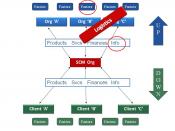In late 2000 and through 2001 the United States Marine Corps came to a realization. Their supply chain systems and logistics databases and methods were antiquated, and something had to be done. So they decided to follow the lead of the other branches of the service and develop the proper technology to integrate their supply chain not only vertically, but horizontally as well. These vast improvements won them the Global Award for Department of Defense Supply Chain Excellence for 2001.
Lieutenant General Richard L. Kelly the Deputy Commandant, Installations and Logistics wrote in their award submission that, "For years, Marine Corps systems acquisition and development had taken place in a vacuum, with little or no cross-functional coordination and no alignment to defined enterprise business objectives. What had resulted was a patchwork nightmare of technology applications and infrastructure that was ineffective and extremely costly to maintain." (www.acq.osd.mil) The Marines started out as guards and a well trained fighting force for ships.
As time went on their mission grew. They eventually were being used on land as a quick strike force which then evolved into an amphibious assault force as well and ultimately what you see today. As they grew so did their logistical requirements, but up until the end of the Korean War they were supported completely by the other services, namely the army and the navy. After the Korean War they decided that they were too large and that this was no longer effective so they developed their own capability for sustainment. (www.globalsecurity.org)This eventually turned into the nightmare previously mentioned by Lt. Gen. Kelly. Eventually studies in the late 90's showed that the USMC's mission was evolving once again, and these new "Operations will likely be quick-strike, vice extended with significant build-up ashore." (www.globalsecurity.org) This larger and long term footprint...


